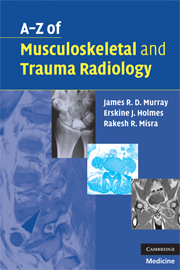Book contents
- Frontmatter
- Contents
- Acknowledgements
- Preface
- List of abbreviations
- Section I Musculoskeletal radiology
- Achilles tendonopathy/rupture
- Aneurysmal bone cysts
- Ankylosing spondylitis
- Avascular necrosis – osteonecrosis
- Femoral-head osteonecrosis
- Kienböck's disease
- Back pain – including spondylolisthesis/spondylolysis
- Bone cysts
- Bone infarcts (medullary)
- Charcot joint (neuropathic joint)
- Complex regional-pain syndrome
- Crystal deposition disorders
- Developmental dysplasia of the hip (DDH)
- Discitis and vertebral osteomyelitis
- Disc prolapse – PID – ‘slipped discs’ and sciatica
- Diffuse idiopathic skeletal hyperostosis (DISH)
- Dysplasia – developmental disorders
- Enthesopathy
- Gout
- Haemophilia
- Hyperparathyroidism
- Hypertrophic pulmonary osteoarthropathy
- Irritable hip/transient synovitis
- Juvenile idiopathic arthritis
- Langerhans-cell histiocytosis
- Lymphoma of bone
- Metastases to bone
- Multiple myeloma
- Myositis ossificans
- Non-accidental injury
- Osteoarthrosis – osteoarthritis
- Osteochondroses
- Osteomyelitis (acute)
- Osteoporosis
- Paget's disease
- Perthes disease
- Pigmented villonodular synovitis (PVNS)
- Psoriatic arthropathy
- Renal osteodystrophy (including osteomalacia)
- Rheumatoid arthritis
- Rickets
- Rotator-cuff disease
- Scoliosis
- Scheuermann's disease
- Septic arthritis – native and prosthetic joints
- Sickle-cell anaemia
- Slipped upper femoral epiphysis (SUFE)
- Tendinopathy – tendonitis
- Tuberculosis
- Tumours of bone (benign and malignant)
- Section II Trauma radiology
Slipped upper femoral epiphysis (SUFE)
from Section I - Musculoskeletal radiology
Published online by Cambridge University Press: 22 August 2009
- Frontmatter
- Contents
- Acknowledgements
- Preface
- List of abbreviations
- Section I Musculoskeletal radiology
- Achilles tendonopathy/rupture
- Aneurysmal bone cysts
- Ankylosing spondylitis
- Avascular necrosis – osteonecrosis
- Femoral-head osteonecrosis
- Kienböck's disease
- Back pain – including spondylolisthesis/spondylolysis
- Bone cysts
- Bone infarcts (medullary)
- Charcot joint (neuropathic joint)
- Complex regional-pain syndrome
- Crystal deposition disorders
- Developmental dysplasia of the hip (DDH)
- Discitis and vertebral osteomyelitis
- Disc prolapse – PID – ‘slipped discs’ and sciatica
- Diffuse idiopathic skeletal hyperostosis (DISH)
- Dysplasia – developmental disorders
- Enthesopathy
- Gout
- Haemophilia
- Hyperparathyroidism
- Hypertrophic pulmonary osteoarthropathy
- Irritable hip/transient synovitis
- Juvenile idiopathic arthritis
- Langerhans-cell histiocytosis
- Lymphoma of bone
- Metastases to bone
- Multiple myeloma
- Myositis ossificans
- Non-accidental injury
- Osteoarthrosis – osteoarthritis
- Osteochondroses
- Osteomyelitis (acute)
- Osteoporosis
- Paget's disease
- Perthes disease
- Pigmented villonodular synovitis (PVNS)
- Psoriatic arthropathy
- Renal osteodystrophy (including osteomalacia)
- Rheumatoid arthritis
- Rickets
- Rotator-cuff disease
- Scoliosis
- Scheuermann's disease
- Septic arthritis – native and prosthetic joints
- Sickle-cell anaemia
- Slipped upper femoral epiphysis (SUFE)
- Tendinopathy – tendonitis
- Tuberculosis
- Tumours of bone (benign and malignant)
- Section II Trauma radiology
Summary
Characteristics
Commonest hip disorder of adolescence (male 13 to 16 years, female 11 to 14 years).
Commoner in boys with a ratio of 3 to 1.
Occurs in approximately 2 in 100,000.
Commoner in obese, but active, patients.
Unknown aetiology, although genetic and traumatic theories have been proposed.
Usually seen during a period of rapid growth when the physis appears to be more susceptible to shear forces.
A history of trauma is given in up to 50% of cases.
60% are bilateral.
Stable (able to weight bear) are distinguished from unstable (not weight bearing) hips. Unstable hips have a 50% risk of future femoral head AVN.
Clinical features
Presents with pain and a limp, not necessarily localised to the hip.
Depending on the chronicity, limb shortening with a degree of external rotation may be present.
Muscle atrophy occurs in delayed presentation.
Pain and limited internal rotation on examination.
Considered chronic if symptoms greater than 3 weeks.
Radiological features
PA and ‘frog leg’ views are the standard views.
Widening of the epiphysis with metaphyseal irregularity.
Posteromedial displacement of the femoral head; this is seen as failure of a line, drawn along the superior femoral neck, to intersect with the femoral head.
Epiphysis appears smaller due to posterior slippage.
Slippage may only be seen on the frog leg view – but avoid frog view if the hip is ‘unstable’.
New bone formation (buttressing) seen late.
Late findings include subchondral sclerosis, cyst formation, osteophyte formation and narrowing of the joint space.
Ultrasound can be a useful adjunct showing an effusion with early slippage.
MRI (bilateral) to look for ‘pre-slip’ if pain but normal X-rays.
Management
Aimed at preventing further slippage and maintaining function. Always consider the contralateral hip.
[…]
- Type
- Chapter
- Information
- A-Z of Musculoskeletal and Trauma Radiology , pp. 149 - 150Publisher: Cambridge University PressPrint publication year: 2008



